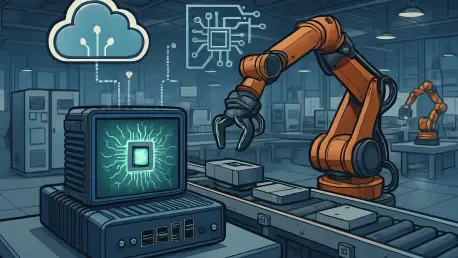Today, we’re thrilled to sit down with Oscar Vail, a trailblazer in industrial technology with a deep focus on emerging fields like quantum computing, robotics, and open-source innovation. With years of experience at the forefront of manufacturing advancements, Oscar is the perfect person to guide us through the transformative potential of edge infrastructure for data-driven manufacturers. In this conversation, we’ll explore why factories are shifting away from traditional data systems, the operational and financial benefits of edge computing, the critical role of rugged hardware, and the unique challenges of adopting this technology in diverse environments.
Why do you think manufacturers are under pressure to overhaul their data systems right now?
Manufacturers are facing a perfect storm of demands that traditional data systems just can’t keep up with. The sheer volume of data from connected machines on the factory floor is exploding, and relying on centralized servers or cloud systems means delays in processing. Those delays can disrupt production, miss critical defects, or slow down decision-making. On top of that, there’s a growing need for real-time insights—whether it’s for quality control or machine maintenance—and sending data halfway across the world to a data center just isn’t feasible anymore. It’s about staying competitive; if you’re not acting on data instantly, someone else will.
How does edge computing specifically improve decision-making speed on the factory floor?
Edge computing cuts out the middleman. By processing data right where it’s generated—say, at a sensor on a production line—you’re making decisions in milliseconds. For instance, if a machine shows a slight anomaly, an edge system can flag it instantly and adjust operations or alert a technician before it turns into a costly breakdown. Compare that to cloud processing, where data has to travel to a remote server and back, which could take seconds or minutes. In manufacturing, those seconds can mean defective products or halted lines, so the immediacy of edge systems is a game-changer.
Can you dive into how edge infrastructure supports operations when connectivity fails?
One of the biggest strengths of edge computing is its autonomy. If your internet connection drops or there’s a glitch with a remote server, a cloud-dependent system grinds to a halt because it can’t access the processing power it needs. Edge systems, on the other hand, keep everything local. They’re designed to run independently, so even during an outage, your factory can continue monitoring machines, tracking output, and maintaining critical functions. It’s a level of reliability that’s essential for manufacturers who can’t afford downtime.
What impact have you seen from edge computing on predictive maintenance in factories?
Predictive maintenance is one of the standout benefits of edge computing. I’ve seen cases where downtime has been slashed by up to 50% because edge systems analyze machine data in real time and spot issues before they escalate. This also extends machine life significantly—sometimes by 30% or more—since you’re not running equipment into the ground. By processing data locally, you get immediate alerts on wear and tear, like unusual vibrations or temperature spikes, allowing maintenance teams to act proactively rather than reactively. It’s a direct boost to efficiency and cost savings.
Why is data sovereignty such a pressing concern for manufacturers, especially in regions like Europe?
In Europe, strict regulations around data privacy and protection are a major driver. Manufacturers there are dealing with laws that dictate where data can be stored and who can access it, often to safeguard intellectual property or sensitive operational details. Sending data to cloud servers—potentially located in another country—raises red flags about compliance and security. Edge computing addresses this by keeping critical data on-site, under the manufacturer’s direct control. It’s not just about meeting legal requirements; it’s about peace of mind knowing your data isn’t exposed to external risks.
What makes hardware so critical for edge computing in harsh factory settings?
Factory floors are brutal environments for tech. You’ve got dust, extreme temperatures, vibrations from heavy machinery, and even electromagnetic interference that can fry standard computers. Edge hardware has to be built tough to handle these conditions without missing a beat. I’ve seen rugged platforms designed specifically for industrial use that can withstand all of this and still deliver reliable performance. Unlike regular laptops or servers, these systems are sealed against contaminants and engineered to operate in wide temperature ranges, ensuring that data processing doesn’t falter no matter the setting.
How does investing in edge infrastructure translate into financial benefits for manufacturers?
The financial case for edge infrastructure is compelling. First, the reduced latency means faster production cycles and better quality control, directly boosting output. If defects are caught instantly, you’re not wasting materials or time on rework. Then there’s the cost savings from less downtime—addressing machine issues before they cause shutdowns saves thousands, if not millions, depending on the scale. Additionally, edge systems cut energy and bandwidth costs since you’re not constantly streaming data to distant servers. It’s a win-win: higher efficiency and lower operational expenses.
What are some of the biggest hurdles manufacturers face when rolling out edge computing?
Adopting edge infrastructure isn’t without its challenges. One major issue is figuring out which processes should move to the edge and which can stay on cloud or centralized systems—it requires a strategic approach to maximize value. Then there’s the integration with older equipment. A lot of legacy machinery wasn’t built for modern connectivity, so bridging that gap often needs custom hardware or middleware solutions, which can be complex and costly. Plus, there’s a learning curve; staff need training to manage and troubleshoot these new systems. It’s not insurmountable, but it does take careful planning and investment.
What’s your forecast for the future of edge computing in manufacturing over the next decade?
I see edge computing becoming the backbone of manufacturing in the next ten years. As more factories adopt IoT devices and generate massive amounts of data, the need for local processing will only grow. I expect we’ll see even smarter edge systems with advanced AI capabilities, enabling not just real-time decisions but also long-term predictive strategies right on the factory floor. Sustainability will also drive adoption—edge systems use less energy than constant cloud communication, aligning with global pushes for greener operations. Ultimately, manufacturers who don’t embrace edge infrastructure risk falling behind as the industry moves toward faster, more autonomous, and data-driven production environments.









